Elsevier投稿指南
Elsevier期刊网上投稿指南(中文版PDF)
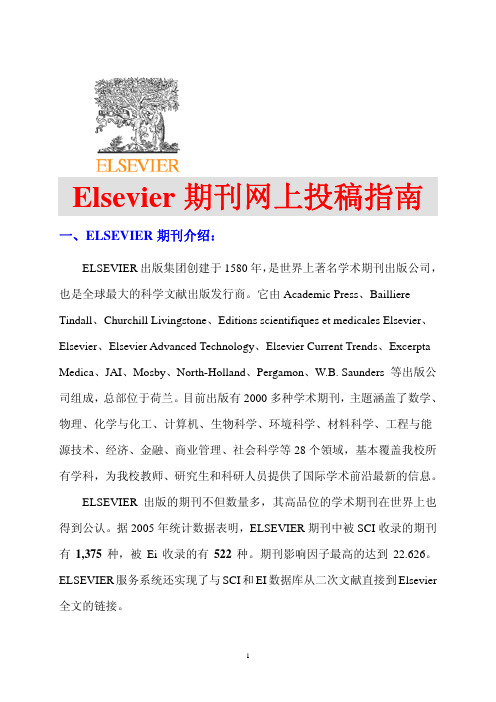
Elsevier期刊网上投稿指南一、ELSEVIER期刊介绍:ELSEVIER出版集团创建于1580年,是世界上著名学术期刊出版公司,也是全球最大的科学文献出版发行商。
它由Academic Press、Bailliere Tindall、Churchill Livingstone、Editions scientifiques et medicales Elsevier、Elsevier、Elsevier Advanced Technology、Elsevier Current Trends、Excerpta Medica、JAI、Mosby、North-Holland、Pergamon、W.B. Saunders 等出版公司组成,总部位于荷兰。
目前出版有2000多种学术期刊,主題涵盖了数学、物理、化学与化工、计算机、生物科学、环境科学、材料科学、工程与能源技术、经济、金融、商业管理、社会科学等28个領域,基本覆盖我校所有学科,为我校教师、研究生和科研人员提供了国际学术前沿最新的信息。
ELSEVIER出版的期刊不但数量多,其高品位的学术期刊在世界上也得到公认。
据2005年统计数据表明,ELSEVIER期刊中被SCI收录的期刊有1,375种,被Ei收录的有522种。
期刊影响因子最高的达到22.626。
ELSEVIER服务系统还实现了与SCI和EI数据库从二次文献直接到Elsevier 全文的链接。
目前,ELSEVIER出版集团在清华大学和上海交通大学图书馆设立镜像服务器,向校园网用户提供电子期刊全文数据库-ScienceDirect OnSite (SDOS)的服务;该站点装载了1995年以来该公司出版的1,774种电子期刊全文数据,文章篇数达2,731,1741篇。
读者也可以访问Elsevier美国主站点—ScienceDirect Online(SDOL)(/)。
SDOS和SDOL数据库均采用校园网范围的IP地址控制使用权限,不需要账号和口令,访问本地镜像和主站点都无需支付国际流量费。
如何在Elsevier期刊上发表文章16492586
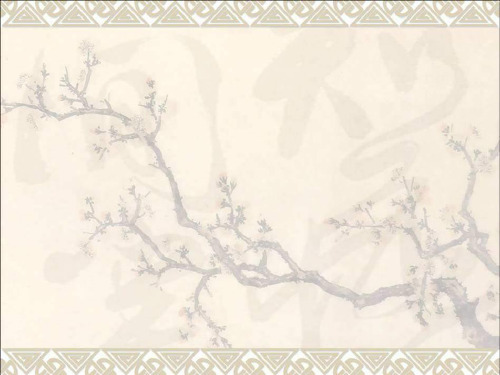
国际期刊编辑对来自中国稿件的看法
“大量 优秀的科技论文 来自中国.” 但是, “存在下述严重问题…”
一稿多投 论文已经在中文期刊上发表 剽窃 (尤其是论文中某一部分存在剽窃)” 研究内容超出期刊范围 格式不符合稿约的要求 推荐不合适的(或不推荐)审稿人 对审稿人的意见没有(恰当的)反馈 英语写作水平不够 退稿后不加修改即再次投稿
“下列问题更加常见”
科技期刊编辑面临的挑战是什么?
极大量的投稿 寻找合适的审稿人
出版道德问题
科技期刊的编辑和你一样是科研工作者! 请精心准备你的论文以减轻他们的负担!
期刊与论文的关系
期刊是科研人员的交流平台
代表某一领域先进的, 非重复性的 研究成果 高质量的期刊 ----- 最具价值的成果
你的论文是进入这个平台的护照
内容是前提: 明确、有价值、令人感兴趣的科研成果 表达是关键: 有逻辑的表达,一步步引领你的读者理 解研究的结论
期刊选择
备选期刊: 期刊宗旨和范围 文章类型 读者对象 当前热点
Example
Example
期刊选择
听取导师或同事的建议
你文章的参考文献或许也是一个启发
Prepare your article
Pre-Submission Peer Review
Automatic Handover
ELSEVIER Editorial-Production
Production
Publication
Fully citable paper
Early web presence
Elsevier期刊投稿和投稿经验

General-Template[Title Page]Article TitleAuthorsAuthor affiliationsCorrespondence information: Corresponding author name, affiliation, detailed permanent address, email address, telephone number(Check the Guide for authors to see the required information on the title page)Put the title of your abstract here using both upper and lower case letters, Times New Roman, 12?pts, bold, centered, double spacedA.?Author a,B.?Author b,C.?Author a,*a Department, University, Street, Postal-Code City, Countryb Laboratory, Institute, Street, Postal-Code City, CountryAbstractThis general template helps you on preparing manuscript for part of Elsevier Journals. Use this document as a template if you are using Microsoft Word 6.0 or later. Here comes self-contained abstract. Please read the Guide for Authors of your target journal for the requirements of Abstract. Pay special attention to the word count.PACS(optional, as per journal):Keywords:Keyword 1.D; Keyword 2.B (Read the Guide for Authors for the requirements for Keywords, including number, thesaurus, and classification indications)* Corresponding author. Tel.: +xx xxx xx xx; fax: +xx xxx xx xx.1. IntroductionThe manuscript should be prepared and submitted according to the Guide for Authors of your taget journal. . For your convenience, brief instructions on manuscript preparation are recorded below.Please DO consult a recent journal paper for style and conventions. You may find samples on ScienceDirect. You need to check your manuscript carefully before you submit it. The editor reserves the right to return manuscripts that do not conform to the instructions for manuscript preparation.2. General remarks on manuscript preparationGenerally, double line spacing, 12 pts font, and Times New Roman are preferred when you type the manuscript for review. This text formatting is provided in order to facilitate referee process and is also required for proper calculation of your manuscript length. Typing your manuscript follows the order: Title, Authors, Affiliations, Abstract, Keywords, Main text, Acknowledgements (optional), References (optional), Figure captions, Figures and Tables. Please consult the Guide for Authors for the proper organization of the main text. Ensure that each new paragraph is clearly indicated. Some journals also require lines to be numbered throughout the manuscript. You will usually want to divide your article into numbered sections and subsections. Present figures and tables at the right places mentioned in the Guide for Authors.Most formatting codes are removed or replaced while processing your article so there is no need for you to use excessive layout styling. Please do not use options such as automatic word breaking, double columns or automaticparagraph numbering (especially for numbered references). Do use bold face, italic, subscripts, superscripts, etc., as appropriate.2.1 IllustrationsMany journals required that figures and tables to be presented on separate pages at the end of the manuscript. The preferable file formats are: EPS (for vector graphics) and TIF (for bitmaps). However, PDF and MS Office (Word, Excel, Powerpoint figures) files are also acceptable. Use file names that enable to identify their contents in terms of figure number and format (e.g. fig1.tif, fig2.eps, fig3.pdf). All artwork has to be numbered according to its sequence in the text. All of them should have captions. Colour figures in printed version require an extra fee for most journals. Generally, no vertical rules (lines) should be used in tables. Illustrations should not duplicate descriptions that appear elsewhere in the manuscript.Please look at for more detailed instructions on artwork preparations.2.2 EquationsConventionally, in mathematical equations variables and anything thatrepresents a value appear in italics. You are encouraged to use equation-editing tools such as mathtype to edit equations. Please make use of the numbering and referencing functions.2.3 CitationsThere are different styles of in-text citations and reference lists. DO consult the Guide for Authors to see the given examples. Pay special attentionto the format of author names, journal names, publication year, volume and page span.AcknowledgementsThis section is optional.References[1].[2].Figure CaptionsFig.1 Put at this page the collected figure captions. The figure captions should be as brief as possible. It should also contain sufficient information that readers do not need to refer to the main text.Fig.2 Put here the figure caption of figure 2 (also the legend to figure 2). Fig. 3Fig.?1. Sample figure. Do not reduce or enlarge any images after placement in an MS Office application as this can lead to loss of image quality. While inserting vector graphics ensure that you use only truetype fonts. These should preferably be in one, or a combination, of the following fonts: Arial, Courier, Helvetica, Symbol, Times.Table 1Sample table: (使用三线表)a(Å) 4.5832 4.9365 Δ E a (eV) 1.745 1.592 ………………a This is an example of a table footnote.关于Elsevier旗下期刊投稿1 关于Elsevier旗下期刊投稿概述(1) Elsevier旗下共有1300多种期刊。
在Elsevier上发表文章的作者指南

作者指南自由模式在你开始之前出版业的道德规范有关出版业道德规范的信息参见A和A中的伦理准则。
利益冲突:所有的投稿人都必须披露从其交稿前三年中可能产生不良影响的且与其工作相关的现实或潜在的利益纠纷,包括任何财务,个人或与其他人或其他组织的关系。
参见A,更深层次的信息的利益冲突的形式可参见A.提交声明和核实提交一篇文章意味着该文章所述工作尚未发布,(可以以摘要的形式发布,或作为学术演讲的一部分的形式,或者以学术论文,或者以电子预定本的形式发布,参见A),而且也没有考虑在其他地方出版。
如果该文章被接受,它的出版需要得到所有作者和主管部门的同意。
而且除非得到了版权持有人的书面同意,不能以同样的形式出版(无论英文或其他语言,纸质还是电子版)。
为了证明独创性,你的文章可能被独创性检测服务测试检验,参见A。
对作品来源作者的改变这一政策是关于已被接受的原稿中作者名字的增添,删减以及名字顺序的重排。
在被接受的稿件发表在网上之前,对于增添,删减,或重排作者名字的要求,必须发送到被接受稿件中有关作者的杂志管理者处,其内容必须包括(a) 作者名字被增加,删减或被重排的原因(b) 所有同意名字增添,删减,或重排的作者的书面确认(电子邮件,传真,信函),在作者被增添或删除的情况中,包括被增添或删改的作者的确认。
那些要求没有发送给相关作者而是由相关作者的杂志管理员提出的人,必须遵循的步骤,注明(1)杂志管理者是由杂志主编告知这一要求(2)直到作者同意,被接受的稿件才能发表到网上。
在被接受的稿件发表到网上之后:任何对于被发表文章中作者名字的增添,删减和重排的要求,将同样遵循上述政策并注明此处为被更改后的结果。
文章转接服务这本杂志是文章转接服务中的一方。
这意味着如果主编感觉你的文章更适合于我们同盟杂志中的任何一家,你将被建议考虑转投给这种另外一家杂志。
如果你同意,将自动以您的名义并不需要任何改动,更多的信息您可以参考A.版权该杂志提供作者对于发表的他们研究的选择:开放式访问或订阅。
爱思唯尔投稿指南课件
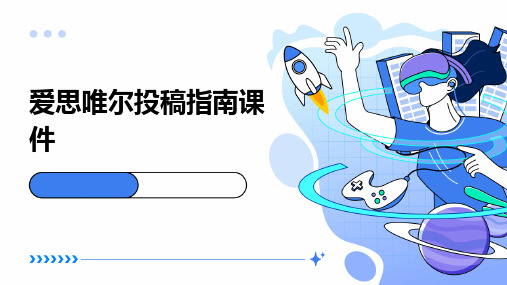
爱思唯尔尊重作者的署名权和作品的完整性,对稿件进行必要的编辑和修 改会事先征求作者意见。
05
与编辑沟通
回复编辑意见
01
仔细阅读编辑的意见和建议,理解其意图和要求。
02
针对每条意见,给出具体的回应和解释,表明自己 的观点和改进措施。
论文在线出版
提交最终稿件
作者需要在规定的时间内,提交最终的稿件到爱思唯尔在线平台。
稿件审核与排版
爱思唯尔会对稿件进行审核和排版,以确保符合出版要求。
论文推广和引用
论文推广
爱思唯尔会通过其官方网站、社交媒体 等渠道,对已发表的论文进行推广,以 提高论文的知名度和影响力。
VS
引用管理
爱思唯尔提供引用管理服务,帮助作者管 理论文引用信息,并生成正确的引用格式 。
爱思唯尔投稿指南课 件
目录
CONTENTS
• 爱思唯尔期刊概览 • 投稿流程 • 稿件要求 • 作者指南 • 与编辑沟通 • 发表和推广
01
爱思唯尔期刊概览
期刊种类
综合性期刊
涵盖多个学科领域的期刊,适合发表跨学科 的研究成果。
专业性期刊
专注于某一学科或领域,发表特定研究方向 的论文。
开放获取期刊
03
避免与编辑产生不必要的争执和冲突,保持友好和 专业的态度。
稿件修订
01 根据编辑的意见和建议,对稿件进行全面检查和 修订。
02 着重修改文章的结构、逻辑、语言表达等方面的 问题,提高文章的质量和可读性。
03 注意保持原意,避免过度修改或改变作者的本意 。
重新提交稿件
01
在完成修订后,将稿件重新提交给编辑进行审核。
Elsevier期刊投稿模板和投稿经验
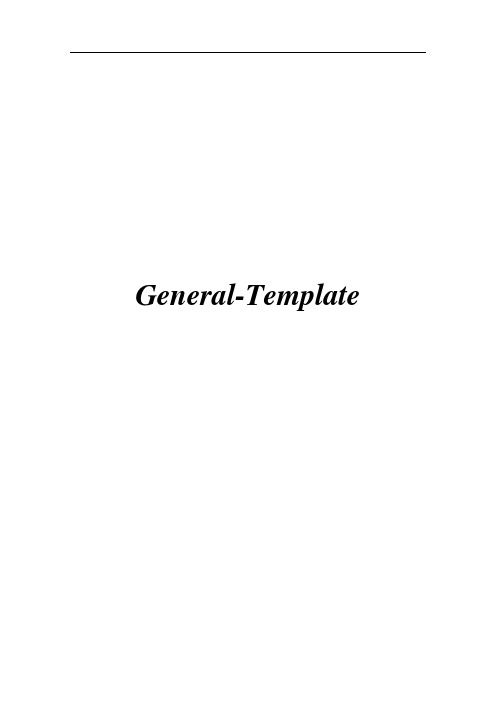
General-Template[Title Page]Article TitleAuthorsAuthor affiliationsCorrespondence information: Corresponding author name, affiliation, detailed permanent address, email address, telephone number(Check the Guide for authors to see the required information on the title page)Put the title of your abstract here using both upper and lower case letters, Times New Roman, 12 pts, bold, centered, double spacedA. Author a,B. Author b,C. Author a,*a Department, University, Street, Postal-Code City, Countryb Laboratory, Institute, Street, Postal-Code City, CountryAbstractThis general template helps you on preparing manuscript for part of Elsevier Journals. Use this document as a template if you are using Microsoft Word 6.0 or later. Here comes self-contained abstract. Please read the Guide for Authors of your target journal for the requirements of Abstract. Pay special attention to the word count.PACS(optional, as per journal): 75.40.-s; 71.20.LPKeywords:Keyword 1.D; Keyword 2.B (Read the Guide for Authors for the requirements for Keywords, including number, thesaurus, and classification indications)* Corresponding author. Tel.: +xx xxx xx xx; fax: +xx xxx xx xx. E-mail address: xxxxx@xxx.xx1. IntroductionThe manuscript should be prepared and submitted according to the Guide for Authors of your taget journal. . For your convenience, brief instructions on manuscript preparation are recorded below.Please DO consult a recent journal paper for style and conventions. You may find samples on ScienceDirect. You need to check your manuscript carefully before you submit it. The editor reserves the right to return manuscripts that do not conform to the instructions for manuscript preparation.2. General remarks on manuscript preparationGenerally, double line spacing, 12 pts font, and Times New Roman are preferred when you type the manuscript for review. This text formatting is provided in order to facilitate referee process and is also required for proper calculation of your manuscript length. Typing your manuscript follows the order: Title, Authors, Affiliations, Abstract, Keywords, Main text, Acknowledgements (optional), References (optional), Figure captions, Figures and Tables. Please consult the Guide for Authors for the proper organization of the main text. Ensure that each new paragraph is clearly indicated. Some journals also require lines to be numbered throughout the manuscript. You will usually want to divide your article into numbered sections and subsections. Present figures and tables at the right places mentioned in the Guide for Authors.Most formatting codes are removed or replaced while processing your article so there is no need for you to use excessive layout styling. Please do not use options suchas automatic word breaking, double columns or automatic paragraph numbering (especially for numbered references). Do use bold face, italic, subscripts, superscripts, etc., as appropriate.2.1 IllustrationsMany journals required that figures and tables to be presented on separate pages at the end of the manuscript. The preferable file formats are: EPS (for vector graphics) and TIF (for bitmaps). However, PDF and MS Office (Word, Excel, Powerpoint figures) files are also acceptable. Use file names that enable to identify their contents in terms of figure number and format (e.g. fig1.tif, fig2.eps, fig3.pdf). All artwork has to be numbered according to its sequence in the text. All of them should have captions. Colour figures in printed version require an extra fee for most journals. Generally, no vertical rules (lines) should be used in tables. Illustrations should not duplicate descriptions that appear elsewhere in the manuscript.Please look at .elsevier./wps/find/authors.authors/authorartworkinstructions for more detailed instructions on artwork preparations.2.2 EquationsConventionally, in mathematical equations variables and anything thatrepresents a value appear in italics. You are encouraged to use equation-editing tools such as mathtype to edit equations. Please make use of the numbering and referencing functions.2.3 CitationsThere are different styles of in-text citations and reference lists. DO consult the Guide for Authors to see the given examples. Pay special attention to the format of author names, journal names, publication year, volume and page span.AcknowledgementsThis section is optional.References[1].[2].Figure CaptionsFig.1 Put at this page the collected figure captions. The figure captions should be as brief as possible. It should also contain sufficient information that readers do not need to refer to the main text.Fig.2 Put here the figure caption of figure 2 (also the legend to figure 2).Fig. 3Fig. 1. Sample figure. Do not reduce or enlarge any images after placement in an MS Office application as this can lead to loss of image quality. While inserting vector graphics ensure that you use only truetype fonts. These should preferably be in one, or a combination, of the following fonts: Arial, Courier, Helvetica, Symbol, Times.Table 1Sample table: (使用三线表)Parameter Compound 1 Compound 2 a (Å) 4.5832 4.9365Δ E a (eV) 1.745 1.592 ………………a This is an example of a table footnote.关于Elsevier旗下期刊投稿1 关于Elsevier旗下期刊投稿概述(1) Elsevier旗下共有1300多种期刊。
Elsevier投稿指南
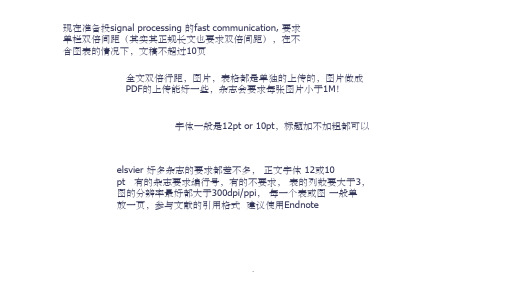
现在准备投signal processing 的fast communication, 要求 单栏双倍间距(其实其正规长文也要求双倍间距),在不 含图表的情况下,文稿不超过10页
全文双倍行距,图片,表格都是单独的上传的,图片做成 PDF的上传能好一些,杂志会要求每张图片小于1M!
字体一般是12pt or 10pt,标题加不加粗都可以
Typing your manuscript follows the order: Title, Author Affiliations, Abstract, Keywords, Main text, Acknowled (optional), References (optional), Figure captions, Figur Tables.
elsvier 好多杂志的要求都差不多, 正文字体 12或10 pt 有的杂志要求编行号,有的不要求, 表的列数要大于3, 图的分辨率最好都大于300dpi/ppi, 每一个表或图 一般单 放一页,参与文献的引用格式 建议使用Endnote
elsevier期刊投稿须知

/infman/登录系统/wps/find/journaldescription.cws_home/505553/authorinstructions用户投稿手册Use of wordprocessing softwareIt is important that the file be saved in the native format of the wordprocessor used. The text should be in single-column format.Keep the layout of the text as simple as possible. Most formatting codes will be removed and replaced on processing the article. In particular, do not use the wordprocessor's options to justify text or to hyphenate words. However, do use bold face, italics, subscripts, superscripts etc. When preparing tables, if you are using a table grid, u se only one grid for each individual table and not a grid for each row. If no grid is used, use tabs, not spaces, to align columns. The electronic text should be prepared in a way very similar to that of conventional manuscripts (see also the Guide to Publishing with Elsevier: /guidepublication). Note that source files of figures, tables and text graphics will be required whether or not you embed your figures in the text. See also the section on Electronic artwork.To avoid unnecessary errors you are strongly advised to use the 'spell-check' and 'grammar-check' functions of your wordprocessor.Article structureAuthors should use a scientific/engineering attitude towards their analyses. The numbers computed should have the appropriate number of significant figures. Please do not use more significant figures than the observations allow (i.e., for most surveys 2 or 3 are sufficient). Decimal fractions should have a leading zero, e.g. 0.001 rather than .001Authors are encouraged to look at the articles recently published inthe journal to understand the aims of the journal.Essential title page information• Title.Concise and informative. Titles are often used in information-retrieval systems. Avoid abbreviations and formulae where possible.• Author names and affiliations.Where the family name may be ambiguous (e.g., a double name), please indicate this clearly. Present the authors' affiliation addresses (where the actual work was done) below the names. Indicate all affiliations with a lower-case superscript letter immediately after the author's name and in front of the appropriate address. Provide the full postal address of each affiliation, including the country name and,if available, the e-mail address of each author.• Corresponding author.Clearly indicate who will handle correspondence at all stages of refereeing and publication, also post-publication. Ensure thattelephone and fax numbers (with country and area code) are provided in addition to the e-mail address and the complete postal address. Contact details must be kept up to date by the corresponding author.• Present/permanent address.If an author has moved since the work described in the article was done, or was visiting at the time, a 'Present address' (or 'Permanent address') may be indicated as a footnote to that author's name. The address at which the author actually did the work must be retained as the main, affiliation address. Superscript Arabic numerals are used for such footnotes.AbstractA concise and factual abstract is required. The abstract should state briefly the purpose of the research, the principal results and major conclusions. An abstract is often presented separately from the article, so it must be able to stand alone. For this reason, References should be avoided, but if essential, then cite the author(s) and year(s). Also, non-standard or uncommon abbreviations should be avoided, but if essential they must be defined at their first mention in the abstract itself.The abstract should not be more than 100 words.KeywordsThe first page of the manuscript should also contain a short list of carefully chosen keywords or content indicators.AcknowledgementsCollate acknowledgements in a separate section at the end of the article before the references and do not, therefore, include them on the title page, as a footnote to the title or otherwise. List here those individuals who provided help during the research (e.g., providing language help, writing assistance or proof reading the article, etc.).ArtworkElectronic artworkGeneral points• Make sure you use uniform lettering and sizing of your original artwork.字体和字号一致• Save text in illustrations as 'graphics' or enclose the font.• Only use th e following fonts in your illustrations: Arial, Courier, Times, Symbol.插图字体• Number the illustration s according to their sequence in the text.插图安先后顺序排序• Use a logical naming convention for your artwork files.• Provide captions to illustrations separately.插图说明• Produce images near to the desired size of the printed version.• Submit each figure as a separate file.分别提交插图A detailed guide on electronic artwork is available on our website:/artworkinstructionsYou are urged to visit this site; some excerpts from the detailed information are given here.FormatsRegardless of the application used, when your electronic artwork is finalised, please 'save as' or convert the images to one of the following formats (note the resolution requirements for line drawings, halftones, and line/halftone combinations given below):EPS: Vector drawings. Embed the font or save the text as 'graphics'.TIFF: Color or grayscale photographs (halftones): always use a minimum of 300 dpi.TIFF: Bitmapped line drawings: use a minimum of 1000 dpi.TIFF: Combinations bitmapped line/half-tone (color or grayscale): a minimum of 500 dpi is required.If your electronic artwork is created in a Microsoft Office application (Word, PowerPoint, Excel) then please supply 'as is'.Please do not:• Supply files that are optimised for screen use (e.g., GIF, BMP, PICT, WPG); the resolution is too low;• Supply files that a re too low in resolution;• Submit graphics that are disproportionately large for the content.Color artworkPlease make sure that artwork files are in an acceptable format (TIFF, EPS or MS Office files) and with the correct resolution. If, together with your accepted article, you submit usable color figures then Elsevier will ensure, at no additional charge, that these figures will appear in color on the Web (e.g., ScienceDirect and other sites) regardless of whether or not these illustrations are reproduced in color in the printed version. For color reproduction in print, you will receive information regarding the costs from Elsevier after receipt of your accepted article. Please indicate your preference for color: in print or on the Web only. For further information on the preparation of electronic artwork, please see /artworkinstructions.Please note: Because of technical complications which can arise by convertingcolor figures to 'gray scale' (for the printed version should you not opt for color in print) please submit in addition usable black and white versions of all the color illustrations.Figure captionsEnsure that each illustration has a caption. Supply captions separately, not attached to the figure. A caption should comprise a brief title (not on the figure itself) and a description of the illustration. Keep text in the illustrations themselves to a minimum but explain all symbols and abbreviations used.Text graphicsText graphics may be embedded in the text at the appropriate position. Further, high-resolution graphics files must be provided separately whether or not the graphics are embedded. See further under Electronic artwork.TablesNumber tables consecutively in accordance with their appearance in the text. Place footnotes to tables below the table body and indicate them with superscript lowercase letters. Avoid vertical rules. Be sparing in the use of tables and ensure that the data presented in tables do not duplicate results described elsewhere in the article.ReferencesCitation in textPlease ensure that every reference cited in the text is also present in the reference list (and vice versa). Any references cited in the abstract must be given in full. Unpublished results and personal communications are not recommended in the reference list, but may be mentioned in the text. If these references are included in the reference list they should follow the standard reference style of the journal and should include a substitution of the publication date with either 'Unpublished results' or 'Personal communication'. Citation of a reference as 'in press' implies that the item has been accepted for publication.Citations to well known facts, statistical and psychological documents, mathematical techniques or articles more than eight years old should, in general, be avoided.Web referencesAs a minimum, the full URL should be given and the date when the reference was last accessed. Any further information, if known (DOI, author names, dates, reference to a source publication, etc.), should also be given. Web references can be listed separately (e.g., after the reference list) under a different headingif desired, or can be included in the reference list.Please only refer to peer reviewed articles.References in a special issuePlease ensure that the words 'this issue' are added to any references in the list (and any citations in the text) to other articles in the same Special Issue. Reference management softwareThis journal has standard templates available in key reference management packages EndNote (/support/enstyles.asp) and Reference Manager (/support/rmstyles.asp). Using plug-ins to wordprocessing packages, authors only need to select the appropriate journal template when preparing their article and the list of references and citations to these will be formatted according to the journal style which is described below.Reference styleText: Indicate references by number(s) in square brackets in line with the text. The actual authors can be referred to, but the reference number(s) must always be given.Example: '..... as demonstrated [3,6]. Barnaby and Jones [8] obtained a different result ....'List: Number the references (numbers in square brackets) in the list in the order in which they appear in the text.Examples:Reference to a journal publication:[1] J. van der Geer, J.A.J. Hanraads, R.A. Lupton, The art of writing a scientific article, J. Sci. Commun. 163 (2010) 51–59.Reference to a book:[2] W. Strunk Jr., E.B. White, The Elements of Style, fourth ed., Longman, New York, 2000.Reference to a chapter in an edited book:[3] G.R. Mettam, L.B. Adams, How to prepare an electronic version of your article, in: B.S. Jones, R.Z. Smith (Eds.), Introduction to the Electronic Age, E-Publishing Inc., New York, 2009, pp. 281–304.Journal abbreviations sourceJournal names should be abbreviated according toIndex Medicus journal abbreviations:/tsd/serials/lji.html;List of title word abbreviations:/2-22661-LTWA-online.php;CAS (Chemical Abstracts Service): /sent.html.Video dataElsevier accepts video material and animation sequences to support and enhance your scientific research. Authors who have video or animation files that they wish to submit with their article are strongly encouraged to include these within the body of the article. This can be done in the same way as a figure or table by referring to the video or animation content and noting in the body text where it should be placed. All submitted files should be properly labeled so that they directly relate to the video file's content. In order to ensure that your video or animation material is directly usable, please provide the files in one of our recommended file formats with a preferred maximum size of 50 MB. Video and animation files supplied will be published online in the electronic version of your article in Elsevier Web products, including ScienceDirect: . Please supply 'stills' with your files: you can choose any frame from the video or animation or make a separate image. These will be used instead of standard icons and will personalize the link to your video data. For more detailed instructions please visit our video instruction pages at /artworkinstructions. Note: since video and animation cannot be embedded in the print version of the journal, please provide text for both the electronic and the print version for the portions of the article that refer to this content.Supplementary dataElsevier accepts electronic supplementary material to support and enhance your scientific research. Supplementary files offer the author additional possibilities to publish supporting applications, high-resolution images, background datasets, sound clips and more. Supplementary files supplied will be published online alongside the electronic version of your article in Elsevier Web products, including ScienceDirect: . In order to ensure that your submitted material is directly usable, please provide the data in one of our recommended file formats. Authors should submit the material in electronic format together with the article and supply a concise and descriptive caption for each file. For more detailed instructions please visit our artwork instruction pages at /artworkinstructions.Submission checklistThe following list will be useful during the final checking of an article prior to sending it to the journal for review. Please consult this Guide for Authors for further details of any item.Ensure that the following items are present:One author has been designated as the corresponding author with contactdetails:• E-mail address• Full postal address• Telephone and fax numbersAll necessary files have been uploaded, and contain:• Keywords• All figure captions• All tables (including title, description, footnotes)Further considerations• Manuscript has been 'spell-checked' and 'grammar-checked'• References are in the correct format for this journal• All references mentioned in the Reference list are cited in the text, and vice versa• Permission has been obtained f or use of copyrighted material from other sources (including the Web)• Color figures are clearly marked as being intended for color reproduction on the Web (free of charge) and in print, or to be reproduced in color on the Web (free of charge) and in black-and-white in print• If only color on the Web is required, black-and-white versions of the figures are also supplied for printing purposesFor any further information please visit our customer support site at ./locate/dss/decsup/default.asp?pg=login.asp陆系统/wps/find/journaldescription.cws_home/505540/authorinstructions#N1 0D2B投稿须知,包含内容:这三项内容需上传Covering Letter ,Highlights ,Manuscript ,Biographical NoteComments,reviewerInformation要求:1,摘要100字,实际272字;2,需要推荐两位评审;3,Comments内容;4,DSS20121007是投Dss的,还是投I&M;我看DSS20121007的作者有邓贵仕老师,而JOC20121007里面的文章有Chuanren Liu。
Elsevier投稿指南

B
5
表的要求是 : All tables are to be numbered using Arabic numerals. Tables should always be cited in text in consecutive numerical order. For each table, please supply a table caption (title) explaining the components of the table. Identify any previously published material by giving the original source in the form of a reference at the end of the table caption. Footnotes to tables should be indicated by superscript lower-case letters (or asterisks for significance values and other statistical data) and included beneath the table body.
现在准备投signal processing 的fast communication, 要求 单栏双倍间距(其实其正规长文也要求双倍间距),在不 含图表的情况下,文稿不超过10页
全文双倍行距,图片,表格都是单独的上传的,图片做成 PDF的上传能好一些,杂志会要求每张图片小于1M!
字体一般是12pt or 10pt,标题加不加粗都可以
1)Elsevier对投稿的稿件格式要求比较松,投稿时选择“Your Paper Your Way”的方式即可。只要你投稿 时的稿件不影响审稿人阅读即可。也就是说你投稿时,直接把visio的图复制到word中就行了,调整好大 小,能看清楚,不影响正常阅读和读图。把所有的图和表按照行文组织穿插在正文中就行了。投初稿时 不用单独上传图、表等附件。只需要上传cover letter和manuscript即可。
从Elsevier的投稿指南可借鉴的东西

从Elsevier的投稿指南可借鉴的东西(1)Elsevier杂志的投稿指南,有人对其进行了全文翻译,尽管有些地方翻译的不是很恰当,但从中我们可以借鉴很多东西,如版权问题,一稿多投问题,图片要求问题等等。
全文如下Guide for Authors 指南作者Submission of manuscripts 提交手稿Types of contribution 类型的贡献Original Research Papers should report the results of original research. 原始的研究论文,应在报告中说明结果的原始研究。
The material should not have been previously published elsewhere, except in a preliminary form.该材料不应此前已在其他地方发表,除在初步形成。
Review Articles can cover either narrow disciplinary subjects or broad issues requiring interdisciplinary discussion. 审查条款可以涵盖或是狭隘学科交叉或广泛性问题,需要跨学科的讨论。
They should provide objective critical uation of a defined subject.它们应当提供客观严谨的评价一项确定的主题。
Reviews should not consist solely of a summary of published data.评语不应当仅仅一个简要的公布数据。
uation of the quality of existing data, the status of knowledge, and the research required to advance knowledge of the subject are essential.质量评价现有的数据,地位,知识和研究所需的先进知识,主题是至关重要的。
SCI论文投稿全过程(Elsevier在线投递)

1 .投稿前询问(presubmi ssi oni nqui r i es)为了节省时间,一些杂志要求作者在投稿前先询问杂志编辑对论文内容是否感兴趣。
询问时提交的材料包括重要性介绍(可用coverletter 内容)和论文摘要。
编辑也许会很快邀请您递交完整的论文(这并不意味着发表的任何承诺),或许告诉您这篇论文不适合在该杂志发表。
如果确认论文重要,即使编辑有否定的回复,作者也可以继续向该杂志投稿。
2. 投稿信(coverletter)coverletter 主要向编辑介绍论文题目、主要内容,突出论文的创新性和价值,希望发表在个该杂志的什么栏目或类型,为什么要发表这篇论文,声明没有一稿两投。
还可以简要指出目前该领域的发展方向,说明该杂志什么领域的读者群对这篇论文感兴趣。
例女口:“Wewouldliketosubmitourmanuscript“xxxxxxxx(manuscripttitle) ”foryourreviewa ndcon siderati on forpublicatio nin thexxx(journal nameJournala sa “xxxx(papertype) ” .Thismanuscriptdescribesoriginalwork, 。
3. 准备论文(preparati on forma nu script)多数杂志要求双倍行距,每一部分最好另起一页,具体格式依据各杂志“投稿须知(In structio nsforauthors) ”中的要求而定。
论文修改定稿之前要仔细阅读所投杂志的“投稿须知”,规定了杂志的范围、论文类型、提交方式、审稿过程、格式要求、版权转让等信息。
标题页(titlepage): 包括题目(title)、作者(author)、单位(institution) 、通讯作者信息(correspondingauthor)、大标题(runninghead)、统计数据(字数、页码、图表数)、资金来源(grantorsupport) 等。
如何使用Elsevier检索文献,及投稿(很有用!)
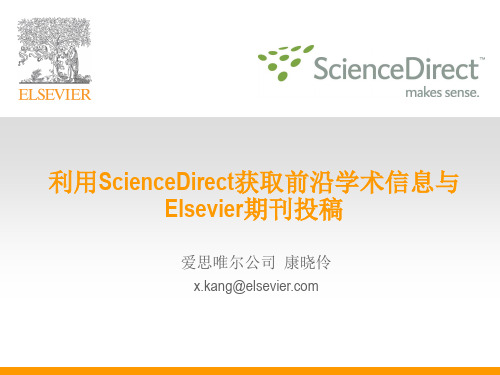
查看最热门文章排行
查看ScienceDirect文章下载次数排行 查看Scopus文章被引次数排行
查看SD上最热门的文章
Scopus: 分学科引用排行
免费资源:诺贝尔奖获奖作者文章
88%的诺贝尔物理奖得主 95%的诺贝尔化学奖得主 79%的诺贝尔医学奖得主 76%的诺贝尔经济学奖得主
诺贝尔奖得主论文免费下载
/nobel2007.htm
更多信息请参考
/sdrevamp.htm
cninfo@ x.kang@
手册
访问权限
学科(全学科/分学科) 1995年至今 IP范围内访问
安徽工业大学07年用量Top 3
Materials Science
Engineering Chemistry
学科
期刊
Journal of Materials Processing Technology Materials Science and Engineering A
无需安装,即可使用。
投稿开始-选择期刊
选择期刊: ScienceDirect / 作者主页
搜索期刊
Submit an article 基本信息
期刊主页 & 作者指南
编辑/编委会
作者指南
学科范围
在线投稿
期刊EES主页 /acronym/
在线客服
作者指南
Elsevier期刊投稿及注意事项
出版流程
如何给Elsevier期刊投稿 EES投稿平台及使用
稿件是如何被评审的 写作过程中需要注意的问题
出版流程
Online Submission EES
Elsevier投稿指南
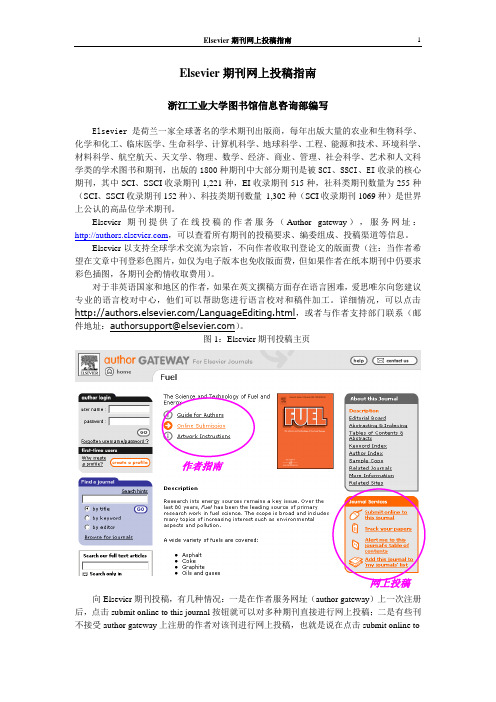
Elsevier期刊网上投稿指南浙江工业大学图书馆信息咨询部编写Elsevier是荷兰一家全球著名的学术期刊出版商,每年出版大量的农业和生物科学、化学和化工、临床医学、生命科学、计算机科学、地球科学、工程、能源和技术、环境科学、材料科学、航空航天、天文学、物理、数学、经济、商业、管理、社会科学、艺术和人文科学类的学术图书和期刊,出版的1800种期刊中大部分期刊是被SCI、SSCI、EI收录的核心期刊,其中SCI、SSCI收录期刊1,221种,EI收录期刊515种,社科类期刊数量为255种(SCI、SSCI收录期刊152种)、科技类期刊数量1,302种(SCI收录期刊1069种)是世界上公认的高品位学术期刊。
Elsevier期刊提供了在线投稿的作者服务(Author gateway),服务网址:,可以查看所有期刊的投稿要求、编委组成、投稿渠道等信息。
Elsevier以支持全球学术交流为宗旨,不向作者收取刊登论文的版面费(注:当作者希望在文章中刊登彩色图片,如仅为电子版本也免收版面费,但如果作者在纸本期刊中仍要求彩色插图,各期刊会酌情收取费用)。
对于非英语国家和地区的作者,如果在英文撰稿方面存在语言困难,爱思唯尔向您建议专业的语言校对中心,他们可以帮助您进行语言校对和稿件加工。
详细情况,可以点击/LanguageEditing.html,或者与作者支持部门联系(邮件地址:authorsupport@)。
图1:Elsevier期刊投稿主页作者指南网上投稿向Elsevier期刊投稿,有几种情况:一是在作者服务网址(author gateway)上一次注册后,点击submit online to this journal按钮就可以对多种期刊直接进行网上投稿;二是有些刊不接受author gateway上注册的作者对该刊进行网上投稿,也就是说在点击submit online tothis journal 按钮后显示该刊不接受在author gateway 注册的用户进行网上投稿,这时需要重新在该刊主页进行注册后方可对该刊进行网上投稿;三是有些刊根本不接受网上投稿,需要邮寄纸本的稿件过去。
Elsevier投稿指南
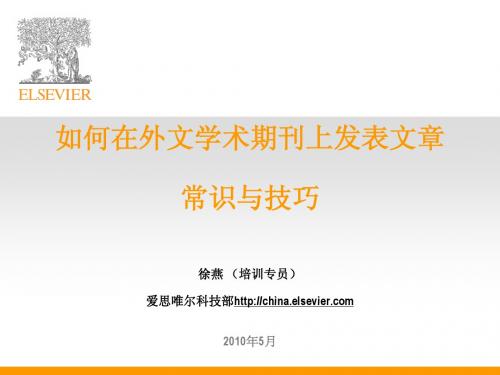
23%
107,784 (17%)* 98,295 (15%)* 653,229
23%
US
53%
52%
52%
Total
40%
38%
37%
Selection of Elsevier Editorial Outflow Statistics
* Number of submissions from the country / Total number of submissions Elsevier received.
文章被接受之后
以在编文章article in press的形式在 ScienceDirect 发表 分配有 DOI 号码并且可以立即被引用
3. 为什么要选择Elsevier?
125年专业出版历史; ISI核心期刊的25% 享誉全球的各学科优秀期刊: The Lancet, Cell, etc. 优秀的作者群体: Galileo, Jules Verne, Stephen W. Hawking, etc.
Example
…” – Author guidelines, Acta Pharmacologica Sinica
一篇研究论文的结构
仔细阅读期刊的投稿指南 “the guide for authors”
Sufficient information Use figures/tables correctly
如何在外文学术期刊上发表文章 常识与技巧
徐燕 (培训专员) 爱思唯尔科技部 2010年5月
日程
1. 外文学术期刊出版流程
2. 如何在外文学术期刊上发表论文——写作、投稿常识 & 提高稿件 接受率的一些技巧
Elsevier+投稿指南
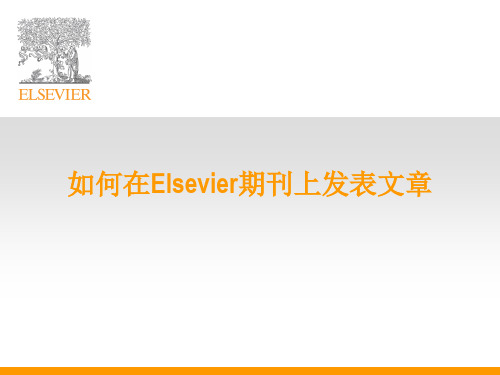
2.EES投稿平台及使用
Elsevier期刊投稿系统
Elsevier Editorial System (EES),集在线投稿、 评审和编辑功能于一体的电子平台。 EES 支持:
作者在线投稿并追踪稿件状态 投稿步骤操作指南 编辑部/编辑在线邀请审稿专家 审稿专家在线审稿 编辑部管理稿件信息 详细数据报告
如何在Elsevier期刊上发表文章
日程
1. 出版流程 2. EES投稿平台及使用 3.提高稿件接受率的技巧 4.为什么选择Elsevier
1.出版流程
出版流程
作者
投递稿件至编辑部
编辑部/编辑
依据审稿专家意见接收 退修或退稿
编辑部/编辑
检查稿件的学科方向 邀请2-3位审稿专家
审稿专家
评估稿件学术 质量给出审稿 意见
“Guide for Authors” often contains useful instructions on scientific writing.
“…
6 Introduction The Introduction summarizes the rationale for the study and gives a concise background. Use references to provide the most salient background rather than an exhaustive review. The last sentence should concisely state your purpose for carrying out the study (not methods, results, or conclusion). … 9 Results Emphasize or summarize only important observations. Simple data may be set forth in the text with no need for tables or figures. Give absolute values, not merely percentages, particularly for the control values. Present your results followed by (Table 1 or Figure 2). Do not write "Table 1 shows that" or "Figure 2 demonstrated that."
elsevier投稿指南

Year
Source: Thomson
按领域划分的中国论文比例
China Papers - Percent Breakdown by Subject Field
Agricultural Sciences Biology & Biochemistry
30
Chemistry Clinical Medicine
走近科技出版 走近作者
爱思唯尔ELSEVIER北京代表处 北京代表处 爱思唯尔
内容
1. 国际科技出版市场概况 2. 科技写作和投稿
1. 国际科技出版市场概况
科技与医学出版行业概况
全球的学术团体通过科技与医学出版这一组织紧密高效运转的 系统有效结合在一起
不同类型的科技医学出版公司
2002年统计,全球约6000家 科技与医学出版公司,其中 2030家主流出版公司出版 的期刊被ISI收录 三种类型的出版公司
爱思唯尔和第三方公司协商,向中国作者推荐语言润色服务。 爱思唯尔和第三方公司协商,向中国作者推荐语言润色服务。
Thank you!
Building Insights, Breaking Boundaries
Non Solus
1880年,雅各布斯·罗伯斯(Jacobus
更有现代感觉的爱思唯尔 ‘Elsevier’
Robbers)决定采用Elzevir命名他的出版社并将其Elzevir改为
随后,罗伯斯家族连续四代从事图书出版直至第二次世界大战. 1947年,爱思唯尔创刊了第一本关于生物化学学科的国际期刊(BBA), 该期刊由独立的国际编委会控制
50000
Papers
40000
30000
20000
10000
Elsevier期刊网上投稿指南
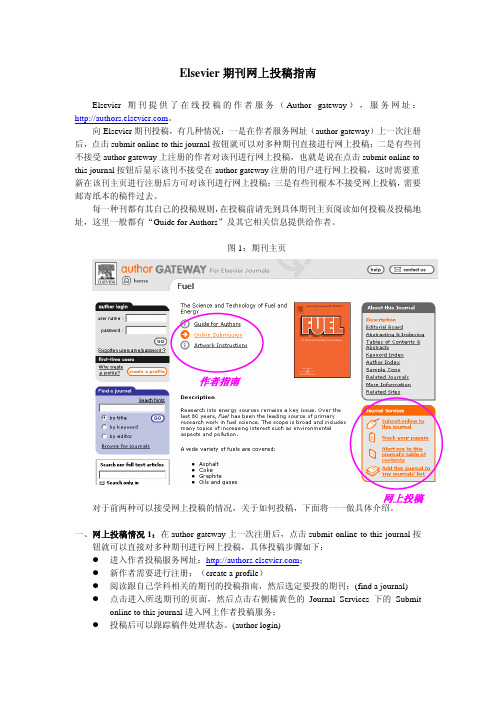
Elsevier期刊网上投稿指南Elsevier期刊提供了在线投稿的作者服务(Author gateway),服务网址:。
向Elsevier期刊投稿,有几种情况:一是在作者服务网址(author gateway)上一次注册后,点击submit online to this journal按钮就可以对多种期刊直接进行网上投稿;二是有些刊不接受author gateway上注册的作者对该刊进行网上投稿,也就是说在点击submit online to this journal按钮后显示该刊不接受在author gateway注册的用户进行网上投稿,这时需要重新在该刊主页进行注册后方可对该刊进行网上投稿;三是有些刊根本不接受网上投稿,需要邮寄纸本的稿件过去。
每一种刊都有其自己的投稿规则,在投稿前请先到具体期刊主页阅读如何投稿及投稿地址,这里一般都有“Guide for Authors”及其它相关信息提供给作者。
图1:期刊主页作者指南网上投稿对于前两种可以接受网上投稿的情况,关于如何投稿,下面将一一做具体介绍。
一、网上投稿情况1:在author gateway上一次注册后,点击submit online to this journal按钮就可以直接对多种期刊进行网上投稿,具体投稿步骤如下:z进入作者投稿服务网址:;z新作者需要进行注册;(create a profile)z阅读跟自己学科相关的期刊的投稿指南,然后选定要投的期刊;(find a journal) z点击进入所选期刊的页面,然后点击右侧橘黄色的Journal Services下的Submit online to this journal进入网上作者投稿服务;z投稿后可以跟踪稿件处理状态。
(author login)1、 进入author gateway :图2:Author Gateway 的页面2、新作者注册:create a profile点击Author Gateway 首页上左侧的create a profile 进行注册,如果做投稿用的话需要填写所有项目。
- 1、下载文档前请自行甄别文档内容的完整性,平台不提供额外的编辑、内容补充、找答案等附加服务。
- 2、"仅部分预览"的文档,不可在线预览部分如存在完整性等问题,可反馈申请退款(可完整预览的文档不适用该条件!)。
- 3、如文档侵犯您的权益,请联系客服反馈,我们会尽快为您处理(人工客服工作时间:9:00-18:30)。
为什么选择Elsevier
中国作者长期的合作伙伴
为什么选择Elsevier?
各学科优秀的期刊 强大易用的EES平台 出版过程中提供的工具与帮助 让你的文章更容易被人发现和引用 ScienceDirect Scirus Scopus 作者无需支付费用
论文吧
专利信息
超过2000万条
USPTO(美国专利局) UKIPO(英国专利局) JPO(日本专利局) EPO(欧洲专利局) WIPO(世界知识产权组织)
机构仓储
接近13万条
Yale University\、MIT、 Stockholm University University of Hong Kong等
选对期刊
选对期刊
备选期刊: 期刊宗旨和范围 文章类型 读者对象 当前热点
Example
Example
反复阅读“Guide for Authors”!
从第一稿开始就按照Guide for Authors 的要求 写作 (格式, 文献的引用, 标题, 图表, 等等). 这样 做既能节省编辑的时间也能节省你自己的时间。
Online Submission EES
Prepare your article
Pre-Submission
Peer Review
Automatic Handover
ELSEVIER Editorial-Production
Production
Publication Fully citable paper
利用Scopus搜索寻 找潜在审稿人
利用Scopus搜索 作者过往发文
编辑和审稿人如何应用Scopus Reviewer in EES
利用Scopus了解该领 域热点、趋势与进展, 评定论文的新颖性
利用Scopus搜索 作者过往发文
What gets you accepted?
向国际期刊投稿
常识-技巧-工具
康晓伶
爱思唯尔科技部
日程
1.为什么要发表 2.出版流程 3. EES投稿平台及使用 4.提高稿件接受率的技巧 5.有效利用科研分析工具 6.为什么选择Elsevier
为什么要发表?
什么样的文章容易发表?
你准备好了吗?
出版流程-以Elsevier为例
Scopus:全球最大的文摘与引文数据库 洞悉研究领域热点和趋势 寻找合作作者和审稿人 选择适合的期刊投稿 …
Scopus: 跨学科的信息导航工具 洞悉研究领域热点和趋势
学术网页
超过4亿个
机构及科学家主页 开放仓储arXiv、NASA 预印本系统、课件等
学术文献
科学、技术、医学及社会科学 4000出版商出版的17000种期刊 包括1000余种开放获取期刊 500余种会议录 600余种商业出版物 超过125种丛书
Example
…” – Author guidelines, Acta Pharmacologica Sinica
投稿信
基本信息包括:
编辑姓名 文章的原创性 主要结论
Exபைடு நூலகம்mple
推荐的评审人
通讯作者 ……
把握编辑直接对话 的最好机会!
有效利用科研分析工具
同行评审过程中涉及的问题:文献+研究人员
作者档案 姓名变体
文章数量
被引用情况 H指数
发表期刊
所属机构
h-Graph
Scopus: 选择适合的期刊投稿
期刊分析器
Scopus:选择适合的期刊投稿
编辑和审稿人如何应用Scopus?
稿件预处理 参考文献校验 为稿件中的参考文献增加Scopus 快速链接
EES与Scopus的集成
Editor 编辑和审稿人如何应用Scopus? in EES
Scopus: 跨学科的信息导航工具 洞悉研究领域热点和趋势
作者分布
文献类型
期刊分布
年度发文情况
学科分布
Scopus: 跨学科的信息导航工具 洞悉研究领域热点和趋势
链接到全文
Scopus: 跨学科的信息导航工具 洞悉研究领域热点和趋势
Scopus:寻找合作作者和审稿人 全面检索作者和机构信息
作者学术背景?
•已发表情况 •合作作者情况
站在谁的肩膀之上
•格式是否符合规范 •参考文献的新颖性和观点 •引用是否贴切
内容的同行评审
•谁是合适的审稿人? •该领域发文最多的作者 •该领域被引频次最高的作者 •观点是否原创、新颖? •当前该研究的热点与趋势
Scopus-不可或缺的科研分析工具
无需安装,即可使用。
投稿开始-选择期刊
选择期刊: ScienceDirect / Elsevier网站
搜索期刊
Submit an article
期刊主页 & 作者指南
学科范围
编辑/编委会
在线投稿
期刊EES主页 /chromb/
作者须知
期刊简介
作者须知
获得Scopus免费试用
Questions
support@ (English) cninfo@
Attention to details Check and double check your work Consider the reviews English must be as good as possible Presentation is important Take your time with revision Acknowledge those who have helped you New, original and previously unpublished Critically evaluate your own manuscript Ethical rules must be obeyed – Nigel John Cook, Editor-in-Chief, Ore Geology Reviews
评审过程严格参照
初次使用需注册/登陆
用户名和密码会自动发 送至注册邮箱
作者主页
投递新稿
投稿步骤
追踪稿件状态
追踪稿件状态
提高稿件接受率的技巧
国际期刊编辑对来自中国稿件的看法
“大量 优秀的科技论文 来自中国.” 但是, “存在下述严重问题…”
一稿多投 论文已经在中文期刊上发表 剽窃 (尤其是论文中某一部分存在剽窃)”
所有的编辑都不愿意在准备不充分的稿件上浪费 时间。这种投稿是对编辑的不尊重。
“Guide for Authors” often contains useful instructions on scientific writing.
“…
6 Introduction The Introduction summarizes the rationale for the study and gives a concise background. Use references to provide the most salient background rather than an exhaustive review. The last sentence should concisely state your purpose for carrying out the study (not methods, results, or conclusion). … 9 Results Emphasize or summarize only important observations. Simple data may be set forth in the text with no need for tables or figures. Give absolute values, not merely percentages, particularly for the control values. Present your results followed by (Table 1 or Figure 2). Do not write "Table 1 shows that" or "Figure 2 demonstrated that."
研究内容超出期刊范围 格式不符合稿约的要求 推荐不合适的(或不推荐)审稿人 对审稿人的意见没有(恰当的)反馈 英语写作水平不够 退稿后不加修改即再次投稿
“下列问题更加常见”
科技期刊编辑面临的挑战是什么?
极大量的投稿 寻找合适的审稿人 出版道德问题
科技期刊的编辑和你一样是科研工作者! 请精心准备你的论文以减轻他们的负担!
Early web presence
稿件是如何被评审的?
同行评审
您的文章会交给评审专家进行评议 同行评审的专家同时也是期刊的作者和读者 您可以推荐备选的评审专家 评审专家对您来说是匿名的 编辑和评审专家会确保您稿件内容不外泄 评审过程严格参照”Guide for Authors”
Elsevier期刊投稿平台
Elsevier Editorial System (EES),集在线投稿 、评审和编辑功能于一体的电子平台。 EES 支持:
作者在线投稿并追踪稿件状态 投稿步骤操作指南 编辑部/编辑在线邀请审稿专家 审稿专家在线审稿 编辑部管理稿件信息 详细数据报告
